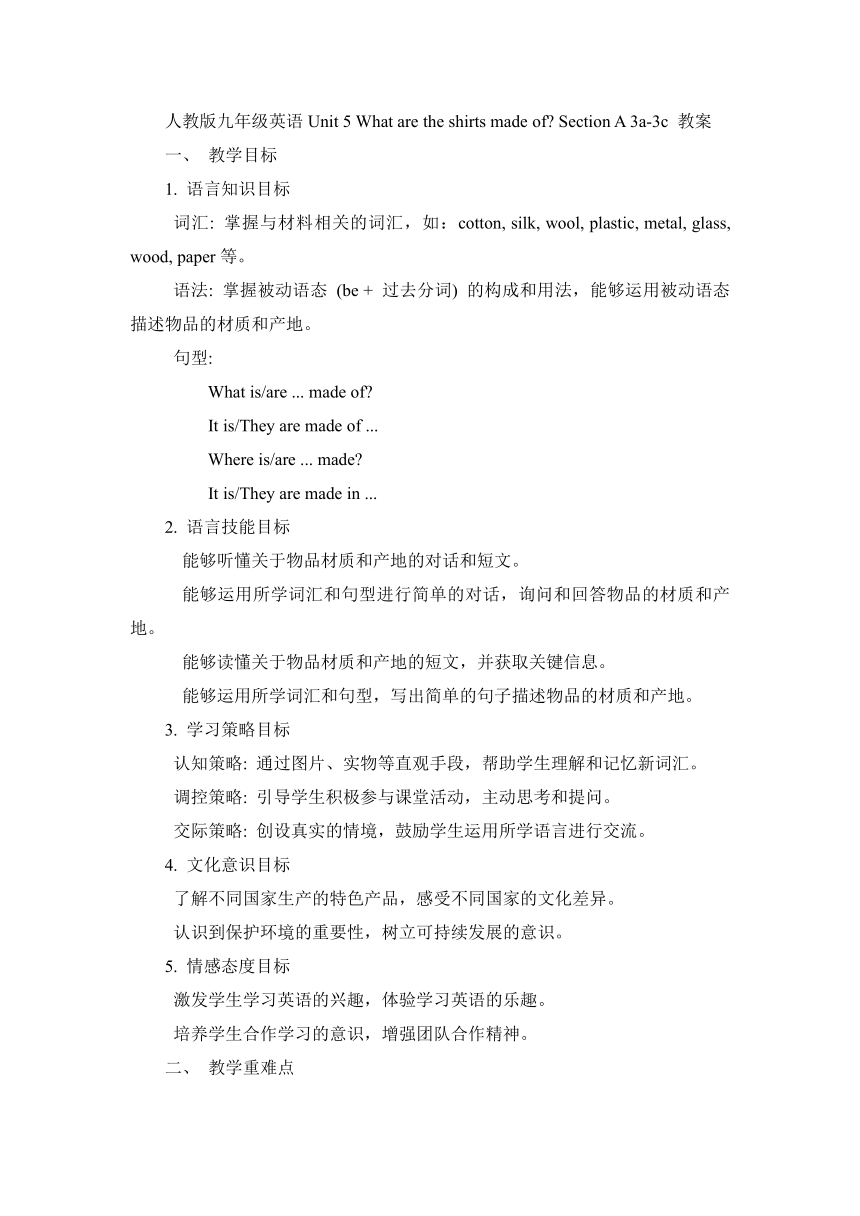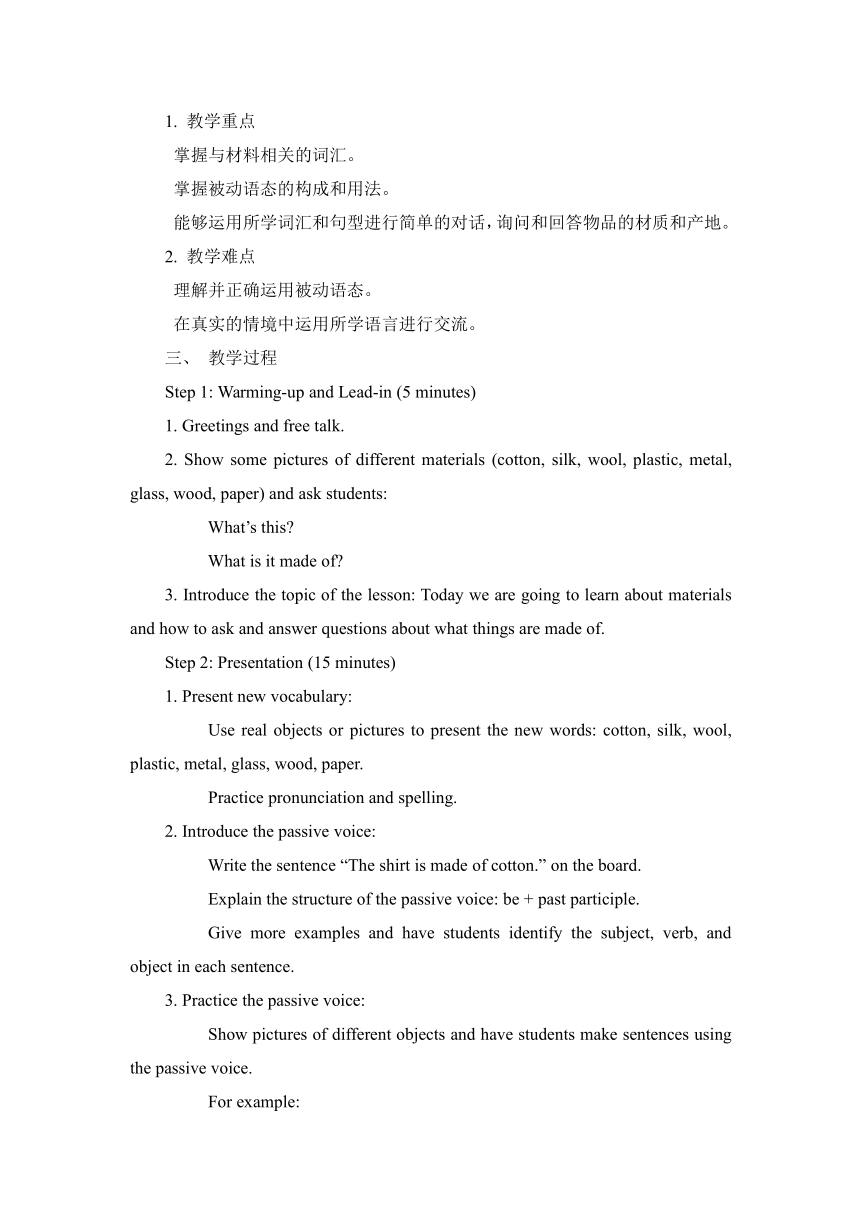人教版九年级英语Unit 5 What are the shirts made of Section A 3a-3c 教案
文档属性
| 名称 | 人教版九年级英语Unit 5 What are the shirts made of Section A 3a-3c 教案 |  | |
| 格式 | doc | ||
| 文件大小 | 27.5KB | ||
| 资源类型 | 教案 | ||
| 版本资源 | 人教新目标(Go for it)版 | ||
| 科目 | 英语 | ||
| 更新时间 | 2025-02-19 10:36:51 | ||
图片预览


文档简介
人教版九年级英语Unit 5 What are the shirts made of Section A 3a-3c 教案
一、 教学目标
1. 语言知识目标
词汇: 掌握与材料相关的词汇,如:cotton, silk, wool, plastic, metal, glass, wood, paper等。
语法: 掌握被动语态 (be + 过去分词) 的构成和用法,能够运用被动语态描述物品的材质和产地。
句型:
What is/are ... made of
It is/They are made of ...
Where is/are ... made
It is/They are made in ...
2. 语言技能目标
能够听懂关于物品材质和产地的对话和短文。
能够运用所学词汇和句型进行简单的对话,询问和回答物品的材质和产地。
能够读懂关于物品材质和产地的短文,并获取关键信息。
能够运用所学词汇和句型,写出简单的句子描述物品的材质和产地。
3. 学习策略目标
认知策略: 通过图片、实物等直观手段,帮助学生理解和记忆新词汇。
调控策略: 引导学生积极参与课堂活动,主动思考和提问。
交际策略: 创设真实的情境,鼓励学生运用所学语言进行交流。
4. 文化意识目标
了解不同国家生产的特色产品,感受不同国家的文化差异。
认识到保护环境的重要性,树立可持续发展的意识。
5. 情感态度目标
激发学生学习英语的兴趣,体验学习英语的乐趣。
培养学生合作学习的意识,增强团队合作精神。
二、 教学重难点
1. 教学重点
掌握与材料相关的词汇。
掌握被动语态的构成和用法。
能够运用所学词汇和句型进行简单的对话,询问和回答物品的材质和产地。
2. 教学难点
理解并正确运用被动语态。
在真实的情境中运用所学语言进行交流。
三、 教学过程
Step 1: Warming-up and Lead-in (5 minutes)
1. Greetings and free talk.
2. Show some pictures of different materials (cotton, silk, wool, plastic, metal, glass, wood, paper) and ask students:
What’s this
What is it made of
3. Introduce the topic of the lesson: Today we are going to learn about materials and how to ask and answer questions about what things are made of.
Step 2: Presentation (15 minutes)
1. Present new vocabulary:
Use real objects or pictures to present the new words: cotton, silk, wool, plastic, metal, glass, wood, paper.
Practice pronunciation and spelling.
2. Introduce the passive voice:
Write the sentence “The shirt is made of cotton.” on the board.
Explain the structure of the passive voice: be + past participle.
Give more examples and have students identify the subject, verb, and object in each sentence.
3. Practice the passive voice:
Show pictures of different objects and have students make sentences using the passive voice.
For example:
T: (show a picture of a wooden chair) What is the chair made of
S: The chair is made of wood.
Step 3: Practice (10 minutes)
1. 3a. Listen and complete the chart.
Play the recording and have students listen and complete the chart.
Check answers as a class.
2. 3b. Pair work: Ask and answer questions about the products in 3a.
Model the conversation with a student.
Have students work in pairs to ask and answer questions about the products in 3a.
Monitor and provide help as needed.
3. 3c. Role-play:
Divide the class into two groups: customers and sales assistants.
Customers ask questions about the products using the passive voice.
Sales assistants answer the questions using the passive voice.
Encourage students to use their imagination and create their own products.
Step 4: Production (10 minutes)
1. Group work: Design a product and write a short description.
Divide the class into small groups.
Each group designs a product and writes a short description using the passive voice.
Groups present their products to the class.
Step 5: Summary and Homework (5 minutes)
1. Summarize the key points of the lesson.
2. Homework:
Write a short paragraph about your favorite product, describing what it is made of and where it is made.
Find out more information about the materials we learned today and share with the class next time.
四、 板书设计
Unit 5 What are the shirts made of
New words:
cotton, silk, wool, plastic, metal, glass, wood, paper
Grammar:
Passive voice: be + past participle
What is/are ... made of
It is/They are made of ...
Where is/are ... made
It is/They are made in ...
五、 教学反思
本节课以“物品材质和产地”为主题,通过图片、实物等直观手段引入新词汇,并结合真实情境进行句型操练,最后通过小组活动进行语言输出,体现了“学中用,用中学”的教学理念。
在教学过程中,我注重引导学生积极参与课堂活动,主动思考和提问,并通过小组合作学习的方式,培养学生的合作意识和团队精神。同时,我也注重将语言学习与文化意识培养相结合,引导学生了解不同国家的文化差异,并树立可持续发展的意识。
当然,本节课也存在一些不足之处。例如,在语法讲解部分,部分学生对被动语态的理解还不够透彻,需要在今后的教学中进一步加强练习。此外,在课堂活动的设计上,还可以更加注重趣味性和挑战性,以更好地激发学生的学习兴趣。
总之,在今后的教学中,我将不断探索和创新,努力打造更加高效、有趣的英语课堂,让学生在学习英语的过程中体验快乐,收获成长。
一、 教学目标
1. 语言知识目标
词汇: 掌握与材料相关的词汇,如:cotton, silk, wool, plastic, metal, glass, wood, paper等。
语法: 掌握被动语态 (be + 过去分词) 的构成和用法,能够运用被动语态描述物品的材质和产地。
句型:
What is/are ... made of
It is/They are made of ...
Where is/are ... made
It is/They are made in ...
2. 语言技能目标
能够听懂关于物品材质和产地的对话和短文。
能够运用所学词汇和句型进行简单的对话,询问和回答物品的材质和产地。
能够读懂关于物品材质和产地的短文,并获取关键信息。
能够运用所学词汇和句型,写出简单的句子描述物品的材质和产地。
3. 学习策略目标
认知策略: 通过图片、实物等直观手段,帮助学生理解和记忆新词汇。
调控策略: 引导学生积极参与课堂活动,主动思考和提问。
交际策略: 创设真实的情境,鼓励学生运用所学语言进行交流。
4. 文化意识目标
了解不同国家生产的特色产品,感受不同国家的文化差异。
认识到保护环境的重要性,树立可持续发展的意识。
5. 情感态度目标
激发学生学习英语的兴趣,体验学习英语的乐趣。
培养学生合作学习的意识,增强团队合作精神。
二、 教学重难点
1. 教学重点
掌握与材料相关的词汇。
掌握被动语态的构成和用法。
能够运用所学词汇和句型进行简单的对话,询问和回答物品的材质和产地。
2. 教学难点
理解并正确运用被动语态。
在真实的情境中运用所学语言进行交流。
三、 教学过程
Step 1: Warming-up and Lead-in (5 minutes)
1. Greetings and free talk.
2. Show some pictures of different materials (cotton, silk, wool, plastic, metal, glass, wood, paper) and ask students:
What’s this
What is it made of
3. Introduce the topic of the lesson: Today we are going to learn about materials and how to ask and answer questions about what things are made of.
Step 2: Presentation (15 minutes)
1. Present new vocabulary:
Use real objects or pictures to present the new words: cotton, silk, wool, plastic, metal, glass, wood, paper.
Practice pronunciation and spelling.
2. Introduce the passive voice:
Write the sentence “The shirt is made of cotton.” on the board.
Explain the structure of the passive voice: be + past participle.
Give more examples and have students identify the subject, verb, and object in each sentence.
3. Practice the passive voice:
Show pictures of different objects and have students make sentences using the passive voice.
For example:
T: (show a picture of a wooden chair) What is the chair made of
S: The chair is made of wood.
Step 3: Practice (10 minutes)
1. 3a. Listen and complete the chart.
Play the recording and have students listen and complete the chart.
Check answers as a class.
2. 3b. Pair work: Ask and answer questions about the products in 3a.
Model the conversation with a student.
Have students work in pairs to ask and answer questions about the products in 3a.
Monitor and provide help as needed.
3. 3c. Role-play:
Divide the class into two groups: customers and sales assistants.
Customers ask questions about the products using the passive voice.
Sales assistants answer the questions using the passive voice.
Encourage students to use their imagination and create their own products.
Step 4: Production (10 minutes)
1. Group work: Design a product and write a short description.
Divide the class into small groups.
Each group designs a product and writes a short description using the passive voice.
Groups present their products to the class.
Step 5: Summary and Homework (5 minutes)
1. Summarize the key points of the lesson.
2. Homework:
Write a short paragraph about your favorite product, describing what it is made of and where it is made.
Find out more information about the materials we learned today and share with the class next time.
四、 板书设计
Unit 5 What are the shirts made of
New words:
cotton, silk, wool, plastic, metal, glass, wood, paper
Grammar:
Passive voice: be + past participle
What is/are ... made of
It is/They are made of ...
Where is/are ... made
It is/They are made in ...
五、 教学反思
本节课以“物品材质和产地”为主题,通过图片、实物等直观手段引入新词汇,并结合真实情境进行句型操练,最后通过小组活动进行语言输出,体现了“学中用,用中学”的教学理念。
在教学过程中,我注重引导学生积极参与课堂活动,主动思考和提问,并通过小组合作学习的方式,培养学生的合作意识和团队精神。同时,我也注重将语言学习与文化意识培养相结合,引导学生了解不同国家的文化差异,并树立可持续发展的意识。
当然,本节课也存在一些不足之处。例如,在语法讲解部分,部分学生对被动语态的理解还不够透彻,需要在今后的教学中进一步加强练习。此外,在课堂活动的设计上,还可以更加注重趣味性和挑战性,以更好地激发学生的学习兴趣。
总之,在今后的教学中,我将不断探索和创新,努力打造更加高效、有趣的英语课堂,让学生在学习英语的过程中体验快乐,收获成长。
同课章节目录
- Unit 1 How can we become good learners.
- Section A
- Section B
- Unit 2 I think that mooncakes are delicious!
- Section A
- Section B
- Unit 3 Could you please tell me where the restroom
- Section A
- Section B
- Unit 4 I used to be afraid of the dark.
- Section A
- Section B
- Unit 5 What are the shirts made of?
- Section A
- Section B
- Review of Units 1-5
- Unit 6 When was it invented?
- Section A
- Section B
- Unit 7 Teenagers should be allowed to choose their
- Section A
- Section B
- Unit 8 It must belong to Carla.
- Section A
- Section B
- Unit 9 I like music that I can dance to.
- Section A
- Section B
- Unit 10 You're supposed to shake hands.
- Section A
- Section B
- Review of Units 6-10
- Unit 11 Sad movies make me cry.
- Section A
- Section B
- Unit 12 Life is full of the unexpected
- Section A
- Section B
- Unit 13 We're trying to save the earth!
- Section A
- Section B
- Unit 14 I remember meeting all of you in Grade 7.
- Section A
- Section B
- Review of Units 11-14
